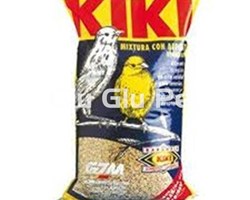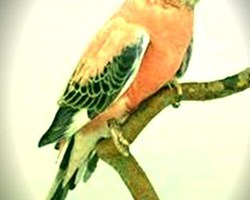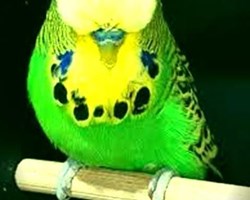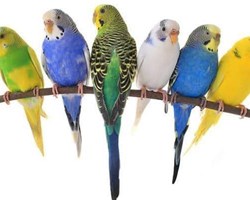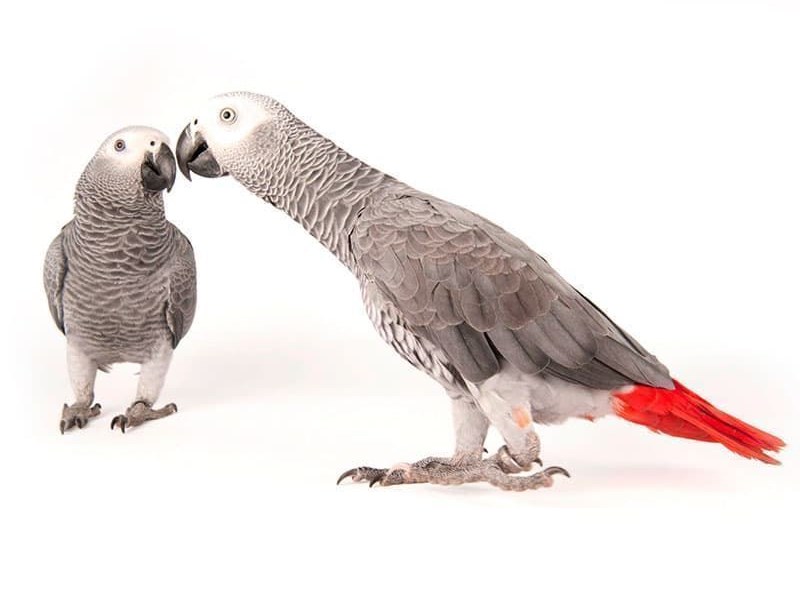
ORIGIN:
The Yaco parrot (Psittacus erithacus), also known as the African Gray Parrot, Red-tailed Gray Parrot or Yaco, is a species of psittaciform bird of the Psittacidae family typical of the African tropical forest.
Its appearance is unmistakable, due to its black beak, its gray plumage and its red tail.
It is a bird characterized by its high intelligence, its ability to memorize and its repetition of words.
The red-tailed gray parrot is a medium-sized parrot.
Its name perfectly describes its appearance except for the tail that is red, its body is covered with feathers with different shades of gray.
Some specimens have red feathers in other parts of the body.
INDEX:
1.- BEHAVIOR.
2.- CHARACTERISTICS.
3.- CLASSIFICATION.
4.- NUTRITION.
5.- PRICE.
6.- CARE.
7.- HEALTH.
1.- BEHAVIOR:
Yacos are gregarious animals that live in hierarchically organized flocks.
Hundreds of individuals can congregate in the same flock.
As happens in most large psittacines, the Yaco establishes stable pair bonds.
At home they are not recommended with small children because the strength of their beak easily hurts seriously and although they do not use their claws aggressively, they are naturally sharp, so special care must be taken.
Taking care of a Yaco is more similar to dealing with a child than with a pet, it demands attention 24 hours a day.
His extreme intelligence and sensitivity easily leads to depression if not reciprocated.
The Yacos have an enormous ability to capture our thoughts, feelings, moods and energy, and force us to face ourselves because their behavior reflects what happens to us inside.
They establish a mate bond with their owner and if one is provided, they turn their devotion to it.
It is an ideal pet, since it is very intelligent and funny.
It is the breed of parrot that has a greater capacity for speech, it can emit "human" sounds after a few weeks of life and over time, it begins to repeat words that it hears from those around it.
Something that characterizes the Yaco parrot is its great intelligence as well as its easy memorization, including the ability to copy words or repeat them and even to be able to modulate sentences.
2.- CHARACTERISTICS:
The main characteristic of this parrot is that it has gray feathers, except for those on the tail, which are deep red, depending on the species, as well as the place or geographical area in which it is found.
BEAK: Black, curved and very strong.
Yellow eyes.
LEGS: A darker gray tone than the rest of the body. They are zygodactyls: they have two fingers forward and two backwards with very powerful claws. They have scales, they are strong and solid, something that is common in psittacea.
MEASURES: 33 cm. long (28-39 cm.).
WEIGHT: 475 GR. (380-600 grams).
Big head.
JAW : Above protruding and curved, it is longer than that below and the point is sharp with a great ability to cut things.
BELLY: Gray like its throat and sides, although it becomes a darker color in the region of the wings and torso, all the variations or changes in the color and size of the parrot depend directly on the subspecies of which the animal is a part.
LONGEVITY: The Red-tailed Yaco parrot is a bird that can easily exceed 40 and 45 years of age, it is known that in captivity they can reach 50 years, even 80 or 85 years of age, although this is relative in reality because it also depends on the care given to it. They can live 70-90 years, and there are extreme cases recorded in specimens that have lived 100 years, it all depends on the food they receive and their living conditions.
SIZE: The size of the Yaco parrot varies in each bird and subspecies by its location. The Gray Parrots that live in Central Africa are larger than the Gray Parrots that live in West Africa.
The differences that exist with respect to the young and adult Yacos parrots include data, such as the color of the feathers being different, as well as the weight and size of the young individuals being smaller than that of the adults.
Chicks that are only a few months old may even have an intensely colored iris, but as the days go by, as they develop, they turn white or gray, but when they are larger, the iris turns light yellow. , which will become a strong yellow when it reaches adulthood and finally, the young Yaco parrot's tail is not red, but the tip is black.
At first glance, the male is barely distinguishable from the female, although the latter is smaller and its plumage is lighter than that of the former.
2.- CLASSIFICATION:
The Kingdom to which the Yaco parrot belongs is cataloged as Animalia, the subkingdom that incorporates it is called Eumetazoa or eumetazoos that refers to nothing more than any animal that has tissues.
The Phylum is the Chordata or that of the Chordates, the subphylum is the Vertebrata or the vertebrates, the class in which it enters is that of birds, the order is that of the Psittaciformes, the family is the Psittacidae or Psittacidae, the genus that involves it is Psittacus and the species is Psittacus Erithacus.
There are three subspecies of the Yaco parrot that are distributed in different geographical parts of Africa, such as:
- Psittacus eruthacus or the gray parrot with a normal red tail.
- Psittacus erithacus Timeneh or as it is known as the gray parrot with a vinegar tail, it lives in the Ivory Coast, in Sierra Leone, in Guinea Bisau and in Liberia.
- Psittacus erithacus princeps that normally inhabits the São Tomé, Princioe and Fernando de Poo islands that remain in the Gulf of Guinea.
3.- NUTRITION:
There are high-quality feeds on the market and even those that are expressly made for this species of bird.
These preparations bring together all the essential nutritional components: vitamins, minerals, proteins, fats and carbohydrates.
In addition, other types of food can be supplied such as vegetables (cress, chard, spinach, etc.), fruits (bananas, apples, strawberries, etc.), seeds and cereals, with the aim of completing a healthy, balanced and balanced diet. complete.
The ideal proportions are:
- 60% I think.
- 30% vegetables and fruits.
- 10% seeds and legumes (preferably cooked or germinated).
A very important fact: you should never feed avocado, as it can poison you.
There are several vitamins that are of great importance for Gray parrots.
These vitamins play a very important role in the development of its full characteristics, such as shine, plumage, etc.
The most important vitamins for Yacos parrots are:
- VITAMIN A: One of the most important in the development of the color and brightness of the feathers. It is very important to emphasize that synthetic vitamins are toxic to them. Synthetic vitamin complexes are not recommended at all. It is advisable to buy them in specialized stores such as Glu Glu Pet .
- VITAMIN B: An excess of Vitamin B is not recommended, the plumage can turn yellow in addition to causing a deficit in the digestive system. The best thing to be able to acquire it is the hard-boiled egg, it is a food that they like very much.
- VITAMIN C: Vitamin C deficiency is closely related to feather pecking and breakage. Vitamin C can be found in different foods such as peppers, oranges, citrus fruits, etc.
The feeding of the yaco is one of the most important aspects that you must take care of when you welcome him home.
That is why you must always have water and food at your disposal.
If its diet contains all the nutrients that a Yaco needs, you will ensure that it enjoys a healthy life, preventing diseases caused by an inadequate diet.
A balanced diet for your Yaco would be based on:
- I think (extruded): It should be the basis of the diet.
- Fresh fruits and vegetables: Fruits and vegetables provide you with vitamins. In addition, when trying new flavors and shapes they are psychologically stimulated. You can give him a different fruit or vegetable every day.
Food suitable for Yaco and quantities:
- Fruit: apple, pear, orange, kiwi, papaya, pomegranate, melon, watermelon, grapes, apricot, plums, guava, pineapple, cherimoyas, cherries, picotas, strawberry and nectarine.
- Vegetables: spinach, chard, lettuce, red pepper, broccoli, corn, carrot, green beans, peas, cucumber, zucchini, broad beans and garlic.
Fruits and Vegetables with a maximum of three days a week: Mango, lemon, grapefruit, banana, tangerine, peach, raspberry, blueberries, persimmon, tomato, green pepper, pumpkin (cooked).
Once a week:
- Cauliflower, lentils, garbanzos, beans (soaked for 24 hours).
- Bread, cooked pasta, cooked rice, muesli.
- Unsalted seeds: millet, peanuts, almonds, pistachios, pumpkin seeds, sunflower seeds, walnuts.
Fruits must be given without seeds or bones and change them daily before they rot.
PROHIBITED FOODS FOR THE YACOS:
- Avocado.
- Chocolate or Cocoa.
- Salt.
- Milk (although if dairy products: fresh cheese, yogurt).
- Meat.
- Carbonated drinks, soft drinks.
- Alcohol, alcoholic beverages.
- Raw potato.
- Coffee or tea.
- Drink of chocolate.
- Eggplants.
- Parsley.
- juices,
- Sugar and sweets.
- Fish.
- fried.
- Foods that contain flavorings or dyes.
- Preserves and spices.
- Garlic,
- Onion.
- Raw tubers.
- Fruit seeds, such as pears or apples.
Our pets are one of the things we love the most, we are always aware of their feeding, maintenance and everything that has to do with care so that their life is extended.
At Glu Glu Pet we present the best feed for parrots, so that you can choose the top one among all, the one that seems best to you, its nutrition is very important because its well-being depends on it:
PSITTACUS : The main objective of Psittacus is to improve the welfare of the birds that we keep in our homes and breeding centers. All products have been formulated to perfectly meet the specific nutritional requirements of birds according to their feeding strategy in the wild, their physiological state and their age.
It is formulated for the stage of reproductive inactivity. Its composition allows to comfortably cover the nutritional needs in these periods.
Daily consumption ranges between 5 and 12% of the animal's weight. Medium-sized species consume around 25-45 gr. up to date.
It is a follow-on slurry formulated to constitute 100% of the parrot's diet: to be used from the moment the quills emerge until emancipation.
It is advisable to prepare the porridge with warm water and an approximate solid concentration of 25%. We recommend giving it to the chick through a soft tube.
For younger animals, it is preferable to use the first age porridge, crop milk for granivorous psittacines. During the emancipation it will be gradually replaced by the Mini formula.
- PSITTACUS HIGH ENERGY PORRIDGE:
Designed to manually rear those parrot species that require high-fat diets (Psittacus, Ara, Po icephalus, Pionites nocephalus).
It is a follow-on porridge that should be used from the moment the quills appear until emancipation.
Indicated for manually rearing those parrot species that require high-fat diets. It contains the most suitable vegetable fat for these species: crude palm oil. It also contains papaya, which favors digestive transit.
In the gray parrot it is used from the third week of life.
It is advisable to prepare the porridge with warm water and with an approximate concentration of solids of 25%. We recommend supplying it to the chick through a soft probe.
In younger animals, it is essential to use first-age porridges such as crop milk for granivorous psittacines or neonatal porridge for granivorous psittacines (for the age of the chick).
During the emancipation it will be gradually replaced by Omega or High Energy breeding.
It is a feed for parrots rich in protein, it is used for daily consumption as it provides several advantages such as weight gain.
This feed is designed to be 100% food, it is recommended to give fruits to vary the diet, the feed alone provides abundant vitamins.
These feeds for parrots are made up of products and by-products of oil seeds and fruits, legume seeds, furctose, vegetable oils, minerals and brewer's yeast, mixtures of flavorings, which contain cassava extracts as well as antioxidant substances, trace elements such as chelate of iron, copper, manganese, zinc, and calcium iodate, another of these compounds are vitamins and provitamins, among which A, D3, E, and choline chloride stand out.
In two formats: bag of 800 gr. and can of 2.3 kgr.
Fully balanced formula for the perfect health of pets.
Ingredients: cereals, oilseed by-products, sunflower oil, brewer's yeast, flaxseed, fruits, lysine, methionine, minerals, inulin.
Complete and balanced food for parrots. I think granulated composed of a wide variety of natural products that will allow your parrots to have a healthy, complete and balanced diet.
Being a feed in granules, it prevents your parrot from selecting the ingredient that it likes the most and discarding the others, taking better advantage of all the nutrients and vitamins.
You can alternate this formula with the VIT FRUIT PRO complementary diet, which provides them with a huge amount of small pieces of fruit and nuts that they enjoy with great delight.
If your parrot tends to gain weight, you can replace LOROVIT PRO with the TROPIVIT PRO formula, a diet with a little less fat but with all the nutrients and vitamins necessary for perfect health, also having a great taste and digestibility.
The quality of the seeds and the perfect packaging keep them fresh and tasty, making them enjoy their flavor with real delight.
In two formats: bag of 800 gr. and can of 2.3 kgr.
Ingredients: cereals, banana, raisins, pineapple, peeled peanuts, papaya, oilseed by-products, sunflower seeds, peeled sunflower seeds, linseed, hazelnuts, almonds, walnuts, minerals, brewer's yeast.
Food for parrots with tropical fruits and nuts. VIT FRUIT PRO is a real treat for your parrots as it contains a huge amount of small pieces of tropical fruit (40%), a wide assortment of nuts (20%) and a complete and balanced feed (40%) which makes it a perfect complement that they taste with authentic delight. You can alternate our VIT PRO mix or with our TROPIVIT PRO and LOROVIT PRO feeds.
In two formats: bag of 800 gr. and can of 2.3 kgr.
Balanced formula for the perfect health of pets.
Ingredients: cereals, seeds, oilseeds, dehydrated banana, peanut, carob, safflower, legume seeds, sorghum, oilseed by-product, pumpkin seeds, hempseed, chillies, flaxseed, minerals, brewer's yeast.
Complete and balanced food for parrots with banana, with its new and improved VIT PRO formula. Our mixture is made up of a varied and careful selection of products that allow your parrots to have a varied, balanced and very appetizing diet.
We have also added peanuts and bananas which allows them to have their nutritional needs perfectly covered, also enjoying this meal with real pleasure.
In two formats: in a bag of 800 gr. and in a 2.3 kgr.
Ingredients: cereals, oilseed by-products, flaxseed, brewer's yeast, fruits, minerals.
Complete and balanced food for parrots. I think granulated composed of a wide variety of natural products that will allow your parrots to have a healthy, complete and balanced diet. Being a feed in granules prevents your parrot from selecting the ingredient it likes the most and discarding the others, taking better advantage of all the nutrients and vitamins.
VERSELE-LAGA:
Ingredients: cereals, seeds (min. 10%, shelled peanuts), fruits (at least 5% fresh fruit), vegetable protein extracts, vegetable by-products, minerals, sugar, L-Lysine, methionine, yucca schidigera extract, fructo- oligosaccharides, vitamins, trace elements.
It is a complete and balanced food for parrots in the form of granules, offering this food to your parrot will prevent it from selecting the grains itself, a selection that frequently causes a balanced diet.
Nutribird P15 has all the necessary nutrients for your parrot, each granule contains a rich selection of cereals, fresh fruit and shelled peanuts. It also contains Florastimul, which strengthens the intestinal flora and prevents stomach disorders.
5.- PRICE:
The price of the Yaco pipillero is quite similar to that of any other exotic parrot.
The price range of the Yaco papillero could be perfectly between 500-800 euros.
Yaco papilleros parrots are bought in breeders, their price has a justification and that is that the price of the Yaco papilleros includes the expenses derived from the licenses and papers that the parrot must have with it, in addition to ensuring that it has been raised and care in correct conditions.
6.- CARE:
You need a comfortable home. It is very important that your space is as large as possible, toys and accessories adapted for this type of bird.
He needs to become your partner, he needs to trust you. For that you must attend to him and several times a day spend some time to play with him.
Adapt your home, eliminate dangerous elements for your Yaco, do not leave him out of the cage unattended, he could bite electrical cables.
The care of a Yaco is very specific due to its ease to get stressed, but also, each bird has different care.
The cage for Yacos should be its little refuge in your home, at least it should allow our bird to spread its wings, it should be metal because it is more resistant and easy to clean.
Accessories can be added to the cages for Yacos: stainless steel drinkers and eaters, ladders, bathtubs and toys.
The top of the cage for Yacos must be open or at least have an area enabled to be outside.
One of the biggest concerns when buying a large parrot cage is durability. This is especially true when planning to house a large parrot. These birds have powerful beaks and amazing intellect, which can be both positive and negative, depending on how they use it.
The cage has to be big enough so that the parrot can open its wings, inside the cage without problems.
It is also recommended that you have a grate on the floor to prevent it from getting on top of your food scraps.
A perch where the animal can perch during periods when it is loose. It is not advisable that your parrot is always inside the cage, a semi-freedom regime is recommended.
Regarding the location of the aviary, you must take into account that the birds tend to perch in high places and feel insecure on the ground, an elevated position of the cage with the perches at chest or eye level of the birds humans will make birds feel safer; less stressed and healthier.
Yaco parrots are very intelligent and need to be entertained, for this at Glu Glu Pet we have the highest quality toys and accessories for your Yaco.
They need to play and be entertained, in addition to exercising their beak and being able to "destroy" objects without problems, these must be safe and suitable for these animals.
The toys must be suitable for being chewed and chopped without danger to him, they must be resistant and durable, they must be used to test the resistance of his beaks.
Toys are not expensive at all and they are something really good in the development of your pet, they are a good substitute for the freedom that has been deprived of it, and they can help you in many facets of your life, such as developing a beak and strong claws or simply not to fall into anxiety and lose their feathers.
For pet birds to have activity and exercise, they must be provided with specific toys for them, they must be provided with specific toys for them, thus satisfying their natural instincts, preventing them from getting bored and presenting undesirable behaviors that may influence their health.
At Glu Glu Pet we offer you different types of toys for Yacos with which they can satisfy these behaviors, some are hanging, sound or bright, thus stimulating curiosity and interest, as well as mirrors, swings or gyms where the bird can climb and exercise.
Toys must be replaced by others, mainly once they are damaged, when this happens we must replace them with others in good condition. Otherwise your Yaco could get hurt.
Below from Glu Glu Pet we show you what are the elements that cannot be missing in the cage of your red-tailed gray parrot:
- NATURAL WOOD PERCHES: The ideal material would be branches of fruit trees of a suitable thickness for the parrot because that way it can hold on safely, and dig its nails into them. Hangers need to be replaced constantly and you should avoid plastic or metal poles. Commercially there are artificial hangers made from a slightly abrasive material to file the nails, as an alternative to natural branches.
- TOYS, BELLS, COLOR BLOCKS AND PECK ROPE: Birds are restless animals and need lots of stimulation to keep their minds occupied.
- DRINKER AND FEEDER: Made of stainless steel, they are the most recommended due to their resistance.
- CONTAINER FOR VEGETABLES OR FRUIT: It is recommended not to mix your mixture of feed and seeds with fresh food, in this way you can remove it daily and it will not mix with your mixture.
- BATH : It will like to take a bath once a week to groom itself and maintain the correct plumage.
- CUTTLEFISH BONE: You will use it to file your beak and nails.
You must extremely deworm the cage every 15 days with specific sprays for birds.
7.- HEALTH:
It is difficult to know if a Yaco is sick, since it will try to hide its indisposition, this curious attitude is due to the fact that in its natural habitat, the jungle, the weakest specimen is abandoned by the group.
- THE PICAJE: The pecking is a problem that we can find with our Yaco. Feathers are bitten and pulled out, even mutilating skin and muscle in the most serious cases. The causes of why this happens are several and very complicated.
- ORNITHOSIS OR PSITACOSIS: Ornithosis is a disease that must be treated immediately. It is also known as a cold, with mucus in inflammation of the eyes. Other symptoms will be diarrhea and drowsiness.
- YACO PARROT COLD: If they have been exposed to currents, or to excessive cold, sneezing may occur, the first measure would be to take them to a warmer place without currents. If the sneezing persists, take them to the vet.
- ASPERGILOSIS: It is a Yaco disease caused by a fungus. It affects the respiratory system making it difficult to breathe. The fungus is usually found on moist seeds, to avoid this clean the cage often and store the food in a dry place.
- HYPOCALCEMIA IN THE YACOS: The main symptoms will be muscle weakness and tremors, in the most serious cases convulsions. To avoid it, there is nothing better than a good diet. Lack of direct sunlight may be yet another reason.
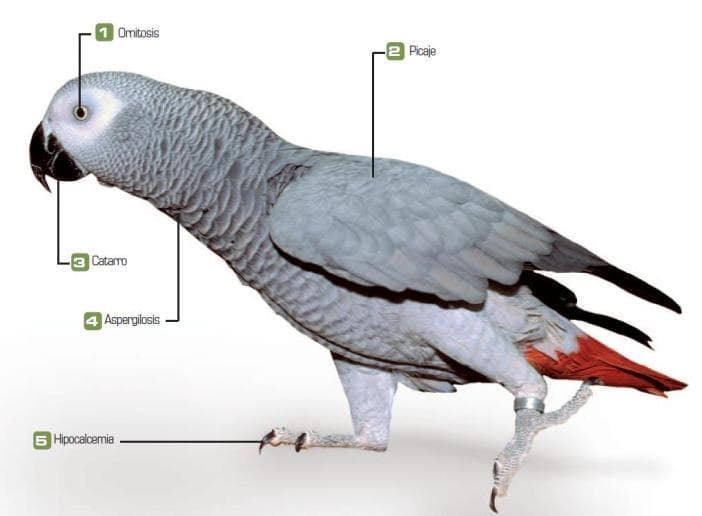
We must observe our parrot and before the alarm signals that in Glu Glu Pet we describe below, go to the veterinarian:
- A healthy Yaco should not hide his head under his wing constantly.
- It should not sway excessively when breathing, over time you will get to know your Yaco and you will be able to differentiate when something happens to him.
- After removing faeces, nearby feathers should be dry and free of debris, if they are, they could be suffering from diarrhoea.
- The feces should be solid and full-bodied, if they are liquid it can point to diarrhea.
- The feces should not be very accompanied by liquid around it.
- It should not have scabs on the beak or legs.
- When we take the Yaco, examine the legs and joints and see that there are no lumps or thickening.
- In the beak are the holes through which it breathes, they should not have mucus.
- Fall of feathers and bald spots.
- Lack of appetite almost always indicates an underlying problem.
- If you detect any change in your parrot, go to the vet.

